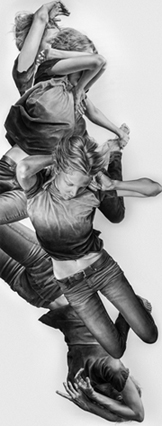A few of the galleries have put on exhibitions that rival those found at museums, and not only the mega galleries, but some select small ones. But you have to look – seek and ye shall find. And that’s exactly what happened on Sunday when I went to see an all-woman artist exhibition at the National Academy. On walking down the stairs from the top I noticed a one-level show, not particularly well-publicized, of a rather extraordinary show of work by John Cage, “The Sight of Silence.” Years in advance of now avant-garde (does anyone besides me use that word anymore?) sound art and the general use of computer art, Cage practiced chance art based on a process that incorporated a set of predetermined rules and parameters. Earphones (not all working unfortunately) provided excerpts of Cage created music. The rolls of dice determined in which gallery a work would hang and on which wall they would hang, the exact location of the work on the wall and then the vertical or horizontal position of the work.
All right, you don’t understand what I am writing. I hardly do myself, but after listening at some length to Cage’s video explanation of how he created his paintings it was beginning to become clear. Frankly, I had always wondered. Hours afterwards I got a glimmer and then I thought about it that evening and finally – I got it. Real art is a constant learning process and do not let anyone tell you differently.
John Cage departed the scene in 1992, after 50 years of influencing the culture of this country, and perhaps the world, as the post-World War II influence on music. His most famous piece was probably 1952’s “4’33” in which a complete orchestra sits, holding instruments, and does nothing. The “music” is the sound of the environment. It dawns on me that might have influenced Andy Warhol’s extraordinarily boring endless films in which nothing happens except the day and night passing in silence. Cage limited his non-music to a bit over four minutes and it made sense. He wanted listeners to hear and be aware of “sounds.”
There is a current run on pretentious conceptual art that flings about stuff and calls it, with great seriousness, “The remembrance of my first day in nursery school and six leagues beond.” Or something like that. It is rather satisfying to enter the thinking processes of a creative intellectual who was neither stayed by jeers nor undone by praise. He was that rare avis, the man who thinks for himself.

